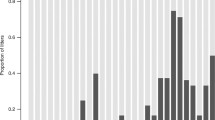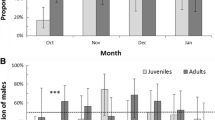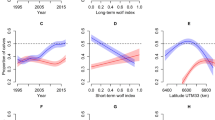Abstract
We used a simple life table approach to examine the age-specific patterns of harvest mortality in eight Norwegian moose populations during the last 15 years and tried to determine if the observed patterns were caused by hunter selectivity. The general opinion among local managers is that hunters prefer to shoot female moose not in company with calves to keep a high number of reproductive females in the population (and because of the emotional stress involved in leaving the calf/calves without a mother), and relatively large males because of the higher return with respect to meat and trophy. In support of the former view, we found the harvest mortality of adult females to be higher among pre-prime (1–3 years old) than prime-aged age classes (4–7 years old). This is probably because prime-aged females are more fecund and, therefore, more likely to be in company with one or two calves during the hunting season. As the season progressed, however, the selection pressure on barren females decreased, probably due to more productive females becoming ‘legal’ prey as their calf/calves were harvested. In males, we did not find any evidence of strong age-specific hunter selectivity, despite strong age-dependent variation in body mass and antler size. We suggest that this was due to the current strongly female-biased sex ratio in most Norwegian moose populations, which leaves the hunters with few opportunities to be selective within a relatively short and intensive hunting season. The management implications of these findings and to what extent the results are likely to affect the future evolution of life histories in Norwegian moose populations are discussed.





Similar content being viewed by others
References
Boer AH (1988) Mortality rates of moose in New Brunswick—a life table analysis. J Wildl Manage 52:21–25
Burnham KP, Anderson DR (2002) Model selection and multimodel inference: a practical information–theoretic approach. Springer, New York Berlin Heidelberg
Bronikowski AM, Clark ME, Rodd FH, Reznick DN (2002) Population-dynamic consequences of predator-induced life-history variation in the guppy (Poecilia reticulate). Ecology 83:2194–2204
Case TJ (2000) An illustrated guide to theoretical ecology. Oxford University Press, Oxford
Caughley G (1977) Analysis of vertebrate populations. Wiley, New York
Chamberlain MJ, Leopold BD, Burger LW, Plowman BW, Conner LM (1999) Survival and cause-specific mortality of adult bobcats in central Mississippi. J Wildl Manage 63:613–620
Coltman DW, O’Donoughue P, Jorgenson JT, Hogg JT, Strobeck C, Festa-Bianchet M (2003) Undesirable evolutionary consequences of trophy hunting. Nature 426:655–658
Coulson T, Guinness F, Pemberton J, Clutton-Brock T (2004) The demographic consequences of releasing a population of red deer from culling. Ecology 85:411–422
Courtois R, Labonte J, Ouellet JP (1998) Movements and location of home range of moose, Alces alces, in eastern Quebec. Can Field Nat 112:602–610
Crete M, Taylor RJ, Jordan PA (1981) Optimization of moose harvest in southwestern Quebec. J Wildl Manage 45:598–611
Ericsson G (2001) Reversed cost of reproduction in moose Alces alces through human harvest. Alces 37:61–69
Ericsson G, Wallin K (1999) Hunter observations as an index of moose Alces alces population parameters. Wildlife Biol 5:177–185
Ericsson G, Wallin K (2001) Age-specific moose (Alces alces) mortality in a predator-free environment: evidence for senescence in females. Ecoscience 8:157–163
Ericsson G, Boman M, Mattsson L (2000) Selective versus random moose harvesting: does it pay to be a prudent predator? J Bioecon 2:1–16
Ericsson G, Wallin K, Ball JP, Broberg M (2001) Age-related reproductive effort and senescence in free-ranging moose, Alces alces. Ecology 82:1613–1620
Ernande B, Dieckmann U, Heino M (2004) Adaptive changes in harvested populations: plasticity and evolution of age and size at maturation. Proc R Soc Lond B Biol Sci 271:415–423
Ferguson (2002) Using survivorship curves to estimate age at first reproduction in moose Alces alces. Wildlife Biol 8:129–136
Ginsberg JR, Milner-Gulland EJ (1994) Sex-biased harvesting and population-dynamics in ungulates—implications for conservation and sustainable use. Conserv Biol 8:157–166
Haagenrud H (1978) Layers of secondary dentine in incisors as age criteria in moose (Alces alces). J Mammal 59:857–858
Hanks J (1981) Characterization of population condition. In: Fowler CW, Smith TD (eds) Dynamics of large mammal populations. Wiley, New York, pp 47–73
Harris RB, Wall WA, Allendorf FW (2002) Genetic consequences of hunting: what do we know and what should we do? Wildl Soc Bull 30:634–643
Koivula M, Koskela E, Mappes T, Oksanen TA (2003) Cost of reproduction in the wild: manipulation of reproductive effort in the bank vole. Ecology 84:398–405
Krebs CJ (1999) Ecological methodology. Addison-Wesley, New York
Langvatn R (1992) Analysis of ovaries in studies of reproduction in red deer (Cervus elaphus): applications and limitations. Rangifer 12:67–91
Langvatn R, Bakke O, Engen S (1994) Retrospective studies of red deer reproduction using regressing luteal structures. J Wildl Manage 58:654–663
Lavsund S, Nygren T, Solberg EJ (2003) Status of moose populations and challenges in moose management in Fennoscandia. Alces 39:109–130
Noyce KV, Garshelis DL, Coy PL (2001) Differential vulnerability of black bears to trap and camera sampling and resulting biases in mark–recapture estimates. URSUS 12:211–226
Olsen EM, Heino M, Lilly GR, Morgan MJ, Brattey J, Ernande B, Dieckmann U (2004) Maturation trends indicative of rapid evolution preceded the collapse of northern cod. Nature 428:932–935
Palkovacs EP (2003) Explaining adaptive shifts in body size on islands: a life history approach. Oikos 103:37–44
Peterson RL (1955) North American moose. University of Toronto Press, Toronto
Reznick DN, Ghalambor CK (2005) Can commercial fishing cause evolution? Answers from guppies (Poecilia reticulate). Can J Fish Aquat Sci 62:791–801
Sand H (1996) Life history patterns in female moose (Alces alces): the relationship between age, body size, fecundity and environmental conditions. Oecologia 106:212–220
Sand H (1998) Costs of reproduction in female moose (Alces alces) as measured by means of phenotypic correlations. Can J Zool 76:187–193
Sibly RM, Barker D, Denham MC, Hone J, Page M (2005) On the regulation of populations of mammals, birds, fish and insects. Science 309:607–610
Solberg EJ, Sæther B-E (1994) Male traits as life-history variables—Annual variation in body-mass and antler size in moose (Alces alces). J Mammal 75:1069–1079
Solberg EJ, Sæther B-E (1999) Hunter observations of moose Alces alces as a management tool. Wildlife Biol 5:107–117
Solberg EJ, Heim M, Sæther B-E, Holmstrøm F (1997) Oppsummering overvåkningsprogram for hjortevilt-Elg. NINA Fagrapp 30:1–68 (in Norwegian with English summary)
Solberg EJ, Sæther B-E, Strand O, Loison A (1999) Dynamics of a harvested moose population in a variable environment. J Anim Ecol 68:186–204
Solberg EJ, Loison A, Sæther B-E, Strand O (2000) Age-specific harvest mortality in a Norwegian moose Alces alces population. Wildlife Biol 6:41–52
Solberg EJ, Loison A, Ringsby TH, Sæther B-E, Heim M (2002) Biased adult sex ratio can affect fecundity in primiparous moose Alces alces. Wildlife Biol 8:117–128
Solberg EJ, Loison A, Gaillard JM, Heim M (2004) Lasting effects of conditions at birth on moose body mass. Ecography 27:677–687
Solberg EJ, Grøtan V, Rolandsen C, Brøseth H, Brainerd S (2005) Change-in-sex ratio as an estimator of population size for Norwegian moose Alces alces. Wildlife Biol 11:163–172
Stearns SC (1992) The evolution of life histories. Oxford University Press, Oxford
Storaas T, Gundersen H, Henriksen H, Andreassen HP (2001) The economic value of moose in Norway—a review. Alces 37:97–107
Stubsjøen T, Sæther B-E, Solberg EJ, Heim M, Rolandsen CM (2000) Moose (Alces alces) survival in three populations in northern Norway. Can J Zool 78:1822–1830
Sutherland WJ (1990) Evolution and fisheries. Nature 344:814–815
Swenson JE, Sandegren F, Bjarvall A, Soderberg A, Wabakken P, Franzen R (1994) Size, trend, distribution and conservation of the brown bear Ursus arctos population in Sweden. Biol Conserve 70:9–17
Sæther B-E, Haagenrud H (1985) Life history of the moose Alces alces: relationship between growth and reproduction. Holarct Ecol 8:100–106
Sæther B-E, Heim M (1993) Ecological correlates of individual variation in age at maturity in female moose (Alces alces): the effects of environmental variability. J Anim Ecol 62:482–489
Sæther BE, Engen S, Solberg EJ (2001) Optimal harvest of age-structured populations of moose Alces alces in a fluctuating environment. Wildlife Biol 7:171–179
Sæther B-E, Solberg EJ, Heim M (2003) Effects of altering sex ratio on the demography of an isolated moose population. J Wildl Manage 67:455–466
Sæther B-E, Solberg EJ, Heim M, Stacy JE, Jakobsen KS, Olstad R (2004) Offspring sex ratio in moose Alces alces in relation to paternal age: an experiment. Wildlife Biol 10:51–57
Tavecchia G, Coulson T, Morgan BJT, Pemberton JM, Pilkington JC, Gulland FMD, Clutton-Brock TH (2005) Predictors of reproductive cost in female Soay sheep. J Anim Ecol 74:201–213
Testa JW (2004) Population dynamics and life history trade-offs of moose (Alces alces) in south-central Alaska. Ecology 85:1439–1452
Venables WN, Ripley BD (2002) Modern applied statistics with S. Statistics and computing. Springer, New York Berlin Heidelberg
Wabakken P, Sand H, Liberg O, Bjarvall A (2001) The recovery, distribution, and population dynamics of wolves on the Scandinavian peninsula, 1978–1998. Can J Zool 79:710–725
Wallin K, Cederlund G, Pehrson Å (1996) Predicting body mass from chest circumference in moose Alces alces. Wildlife Biol 2:53–58
Acknowledgements
We would like to thank Jos Milner, Nils Chr. Stenseth, Anne Loison and two anonymous referees for useful comments on the manuscript. EBN was funded by a grant from Norwegian Research Council (NFR proj. nr 156367/530).
Author information
Authors and Affiliations
Corresponding author
Electronic supplementary material
Rights and permissions
About this article
Cite this article
Nilsen, E.B., Solberg, E.J. Patterns of hunting mortality in Norwegian moose (Alces alces) populations. Eur J Wildl Res 52, 153–163 (2006). https://doi.org/10.1007/s10344-005-0023-1
Received:
Accepted:
Published:
Issue Date:
DOI: https://doi.org/10.1007/s10344-005-0023-1




